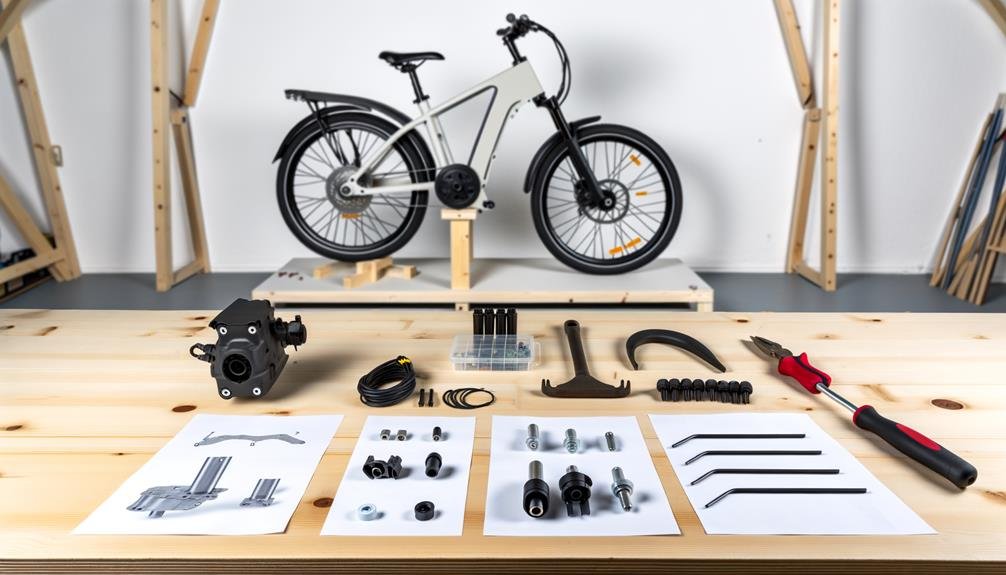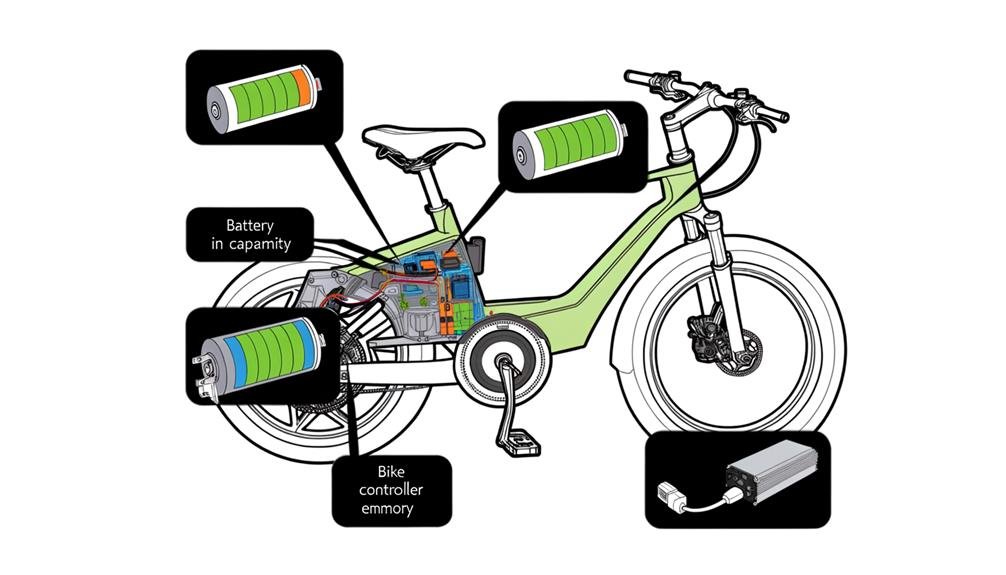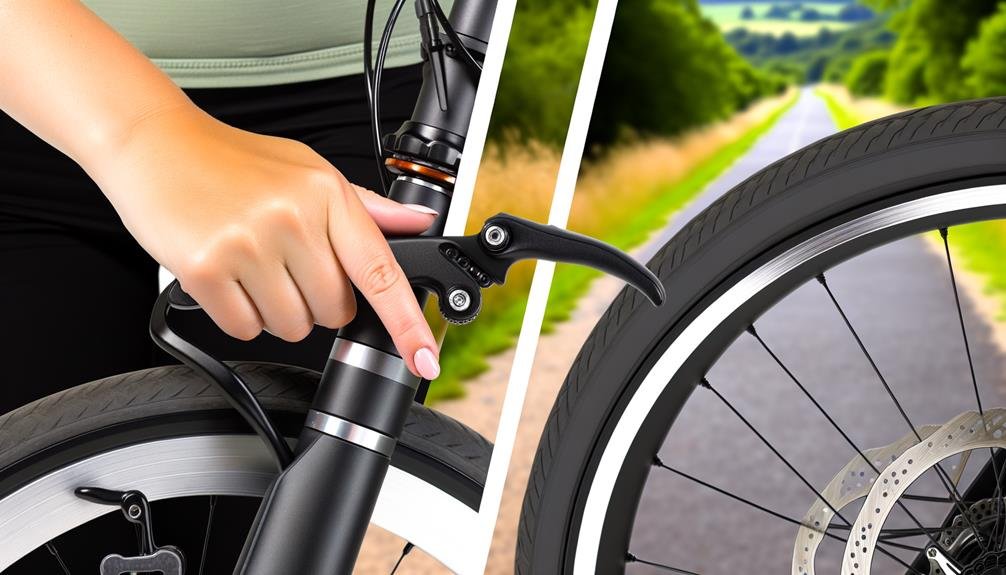Charles Miller is a veteran bike enthusiast with over 12 years of experience dealing with bikes as a mechanic. Despite immense love and expertise for...
The longevity of e-bike brake pads is a subject of considerable interest to both casual riders and enthusiasts alike. This critical component's durability can be influenced by a myriad of factors, including the brake pad compound, the frequency and conditions of riding, and the individual's style of biking.
While the standard estimates range from 500 to 4000 miles or a span of 2 to 5 years, the actual duration can fluctuate significantly, underscoring the importance of regular inspection and timely replacement for optimal braking performance and rider safety.
To gain a comprehensive understanding of this topic, it is necessary to examine the various aspects that contribute to the lifespan of e-bike brake pads, as well as effective strategies for maintenance.
Key Takeaways
- E-bike brake pads come in different compounds and have a lifespan ranging from 500 to 4000 miles.
- Factors such as riding conditions, frequency of use, and maintenance practices influence brake pad wear.
- Different types of brake pads have varying levels of durability, with organic, metallic, and ceramic pads being common options.
- Regular inspection, timely replacement, and proper maintenance are crucial for maximizing brake pad lifespan and ensuring optimal braking performance.
Understanding E-Bike Brake Pads
While it may seem trivial to some, understanding the composition and lifespan of e-bike brake pads is crucial. They come in a variety of compounds such as organic, metallic, or ceramic, each offering different levels of durability and braking performance.
The lifespan of your ebike brake pads can range extensively, from 500 to 4000 miles. This range is influenced heavily by factors such as riding conditions and the frequency with which you use the brakes. Brake pads wear can be expedited by wet or muddy conditions, rough terrain, and frequent usage. Conversely, dry conditions and less frequent use can extend their lifespan.
Recognizing signs of wear is integral to maintaining the optimal functioning of the braking system. Worn-out brake pads are often characterized by squeaking or grinding noises, reduced braking power, and the physical thinning of the pads.
To maximize the lifespan of your ebike brake pads, there are several steps you can take. Avoid harsh conditions, use both brakes evenly to distribute wear, avoid abrupt stops, and keep the braking system clean. Regular inspections are imperative, and brake pads need to be replaced timely when they reach their wear limit to guarantee peak performance. By following these guidelines, you can ensure that you can depend on your ebike brake pads regularly.
Factors Influencing Brake Pad Durability
The durability of e-bike brake pads is contingent upon several variables. These variables include the riding conditions, the quality of the brake pads, and the frequency and quality of maintenance.
One factor that can accelerate brake pad wear is the terrain and weather an e-bike is exposed to. Riding on rough or hilly terrain, or in wet and muddy conditions, can put additional strain on the brake pads and lead to faster deterioration. Similarly, the weight of the rider and their riding style can also impact the lifespan of the brake pads.
Another important factor to consider is the type of brake pads used. E-bike brake pads are typically available in three different types: organic, metallic, and ceramic. Each type has its own advantages and disadvantages, including differences in durability. Organic brake pads are generally softer and provide good initial bite, but tend to wear out more quickly. Metallic brake pads offer better heat dissipation and durability, but can be noisier and may cause more wear on the brake rotor. Ceramic brake pads, while more expensive, offer excellent heat resistance and longevity.
Regardless of the type of brake pads used, regular inspection and timely replacement are crucial for ensuring their durability. It is recommended to regularly check the brake pads for signs of wear, such as thinning or uneven surfaces. Once the brake pads have reached their wear limit, they should be promptly replaced to maintain optimal braking performance and safety.
Riding Conditions Impact
Ebike brake pad longevity is significantly influenced by riding conditions, with factors such as weather, terrain, and frequency of use playing crucial roles in the wear and tear process.
- Weather: Riding in wet or muddy conditions can accelerate brake pad wear due to increased friction and debris. Conversely, dry conditions can help prolong life by reducing abrasive wear.
- Terrain: Rough terrains involve more frequent and aggressive use of brakes, thus brake pads wear out faster.
- Frequency of Use: More frequent riding means more brake use, leading to quicker wear.
It's essential to regularly check your brake pads and note the time to replace them when worn. The condition of your brake largely depends on your riding style.
Quality of Brake Pads
In assessing the quality and durability of e-bike brake pads, one must consider several key factors such as the material composition, environmental conditions, frequency of use, and rider's braking habits.
The thickness of the brake pads can vary depending on the material used; organic, metallic, or ceramic. Each type has its own attributes affecting the braking power, noise, and wear on the disc brake rotor.
Severe environmental conditions can also shorten the lifespan of brake pads. Regular bike usage can lead to frequent braking, causing premature wear. Rider's braking habits, like sudden stops, contribute to this effect.
The quality of the brake pads is crucial, hence, replace them when indicators of wear appear. Remember, a good electric bike performance depends largely on the quality and condition of the brake pads.
Regular Maintenance Importance
While the quality of brake pads undeniably plays a significant role in the performance and safety of e-bikes, regular maintenance is another crucial factor that can considerably influence the durability and longevity of these essential components. Understanding the regular maintenance importance is key in extending the lifespan of your e-bike brake pads.
Regularly check the brake pads for wear and tear. The following signs can indicate the need for new pads:
- Excessive brake wear, visible through thinning pads
- Changes in braking performance
Always check the rotor condition when replacing the brake pads. A damaged rotor can lead to premature brake pad wear.
Cleaning and lubricating the brakes regularly can greatly reduce brake wear and extend the lifespan of your brake pads.
Identifying Worn Out Brake Pads
Recognizing the signs of brake wear is essential in maintaining your ebike's safety and performance. This includes monitoring for reduced braking power, unusual noises, and irregular vibrations during braking.
Physically inspecting the brake pads for thinness or absent wear indicators is also important.
Furthermore, understanding how to accurately measure brake pad thickness and the implications of riding with damaged pads can help riders ensure optimal braking performance and extend the overall lifespan of ebike brake pads.
Signs of Brake Wear
To maintain optimal safety and performance of your ebike, it is crucial to be aware of the signs of brake wear. These signs include a squeaking or grinding noise when applying the brakes, which is indicative of worn-out brake pads.
- *Applying the brakes*: If you hear a squeaking or grinding noise, your brake pads might be worn out and need replacing.
- *Braking performance*: Reduced braking power and longer stopping distances are signs of brake wear.
- *Visual inspection*: Thinner brake pads or a wear indicator line that's no longer visible suggest it's time for a replacement.
Regular monitoring of the condition of your e-bike brake pads can prolong the lifespan of your ebike. Replacing your e-bike brake pads and ensuring they're in good condition enhances your braking performance and ensures safety.
Measuring Brake Pad Thickness
Ensuring the longevity of your e-bike's brake system involves a crucial step: accurately measuring the thickness of the brake pads. This technical process necessitates the use of a caliper or a ruler to check the pad's depth.
For most e-bike brake pads, the new thickness is about 139 millimeters, slowly wearing down over time to reach the wear limit of 3-5mm. Beyond this point, continued use can damage the rotor.
It is, therefore, essential to regularly monitor your brake pads' thickness, comparing the current state to the manufacturer's specifications. By doing this, you ensure that the pads are replaced at the right time, enhancing your e-bike's braking performance and your safety.
Impact of Damaged Pads
Spotting the signs of worn-out brake pads is a vital aspect of maintaining your e-bike's optimal braking performance and ensuring safety on the road. The impact of damaged pads can seriously affect your ability to stop the bike, reducing the effectiveness of both the front brake and the rear brake.
- Average Lifespan of E-Bike Brake: Worn-out pads need to be replaced regularly to extend the brake's lifespan.
- Signs of Wear: You'll notice reduced braking power, squeaking or grinding when making contact with the rotor.
- Serious Safety Concerns: Damaged pads can increase the risk of accidents due to brake less effectiveness.
Timely identification and replacement of worn brake pads not only prolongs the lifespan of your e-bike's brakes but also ensures a safe and smooth ride.
Estimated Lifespan of E-Bike Brake Pads
While the materials used in e-bike brake pads, such as organic, metallic, or ceramic compounds, have their own unique characteristics, their estimated lifespan can range between 500 to 4000 miles or 2 to 5 years. This average lifespan of e-bike brake pads is significantly influenced by factors such as riding conditions, the frequency of use, and the specific type of brake pads employed.
The durability of these types of brake pads can vary depending on the material of the brake pad. Organic compounds tend to wear quicker than their metallic or ceramic counterparts, although all pads will wear down over time and eventually reach their wear limit. It's essential to regularly check your pads for any signs of wear and replace them with new brake pads as needed.
Several factors affect the lifespan of your e-bike's brake pads. Riding in harsh conditions, such as wet or muddy environments, can accelerate wear, while consistent use without adequate maintenance can also reduce the lifespan. Therefore, to ensure the longevity of your e-bike's brake pads, it's indispensable to maintain a regular check on the pad material and ensure timely replacement.
Extending Your Brake Pads' Life
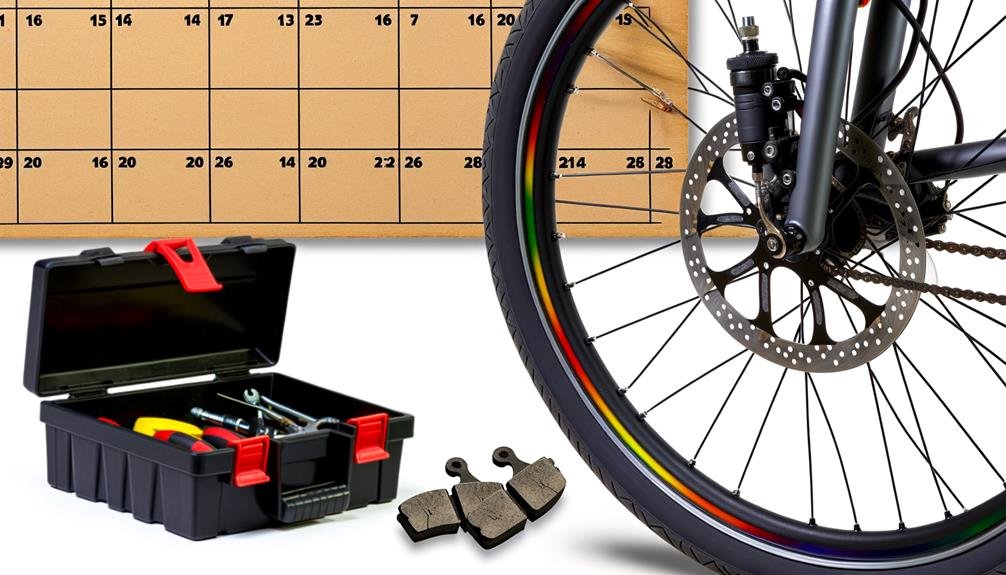
To extend the lifespan of your e-bike's brake pads, regular inspection and immediate replacement when necessary are paramount, along with careful consideration of factors such as riding style, terrain, and brake pad quality. It's important to replace E-Bike Brake pads when they're worn to ensure optimal performance and safety.
Here are some additional tips to extend the lifespan of your e-bike brake pads:
- Riding Style and Speed: Aggressive riding and high speed can wear down the front pads faster. Use the brake lever gently and apply gradual, even pressure for smooth stops.
- Terrain and Disc Brakes: Rough terrain can lead to more frequent use of disc brakes, which in turn can affect the lifespan of brake pads. Choose routes with gentle slopes when possible.
- Brake Pad Quality and Maintenance: High-quality brake pads with integrated heat sinks offer better heat dissipation, which can prolong their life. Regular cleaning and maintenance of the disc and brake system can also contribute to a longer lifespan.
Guide to Replacing Brake Pads
Embarking on the task of replacing your e-bike's brake pads requires a meticulous approach and the right set of tools, ensuring both safety and enhanced performance of your ride. The process involves differentiating between Disc Pads and Rim brakes, with the former requiring a front rotor replacement.
Below is a step-by-step guide for the ebike rider:
| Step | Disc Pads | Rim Brakes |
|---|---|---|
| 1 | Loosen the 5mm bolt on the brake caliper | Loosen the brake cable with a 3mm Allen wrench |
| 2 | Remove the old brake pads | Remove the brake pads from the brake arms |
| 3 | Install new organic pads, ensuring they face the right direction | Install the new brake pads, making sure they align with the rim |
| 4 | Tighten the 5mm bolt, check alignment with the front rotor | Reattach the brake cable, adjust for stopping power |
City riding and hard braking can affect brake pad longevity. Regular inspection and replacement of your brake pads will not only improve your stopping power but also make them last longer. As an ebike owner, understanding the technical aspects of your ride fosters a sense of belonging and empowers you to make informed decisions.
Relevant E-Bike Maintenance Issues
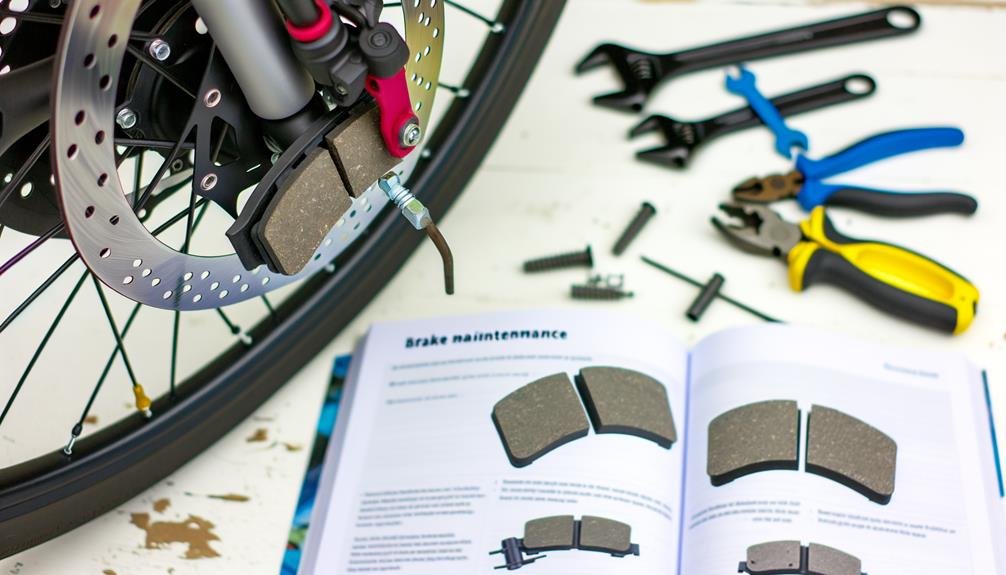
In the realm of e-bike maintenance, understanding the lifespan and proper care of different types of brake pads—organic, metallic, and ceramic—is crucial for optimal performance and safety. The average lifespan of an e-bike varies significantly, influenced by several factors such as usage, maintenance, and the quality of components like the Electric Bike Hub Motor.
E-bike maintenance encompasses:
- Brake Pad Care: Regular inspections for wear and tear, cleaning, and timely replacement can extend the life of your e-bike and ensure you can slow down or stop when required.
- Motor Maintenance: Addressing Electric Bike Hub Motor Problems promptly can prevent further complications. A comprehensive guide to Hub Motor maintenance can be invaluable.
- Riding and Storage Practices: Protecting the e-bike from harsh weather conditions and avoiding abrupt stops can prolong the life of components like brake pads, whether ceramic or metallic.
Keep in mind, safety on the road should always be paramount. Regular maintenance mitigates common issues like Hub Motor Problems, while ensuring your e-bike performs optimally throughout its lifespan. Thus, understanding and addressing relevant e-bike maintenance issues is not just a necessity—it's an integral part of the e-bike ownership experience.
Frequently Asked Questions
When Should I Replace My Ebike Brake Pads?
Ebike brake pads should be replaced when brake noise escalates, braking efficiency reduces, or visible pad material is less than 1mm. Riding conditions, cost factors, and pad maintenance can influence replacement frequency for safety precautions.
How Often Do Bike Brake Pads Need to Be Replaced?
Bike brake pads typically require replacement every 2-5 years, depending on pad material quality and usage. Regular brake maintenance, attention to wear indicators, and seasonal care can improve lifespan, despite variable costs of pads and installation methods.
How Long Do Ebike Brakes Last?
Ebike brakes' lifespan varies based on brake materials, pad types, and riding conditions. Maintenance frequency impacts brake performance. Manufacturer recommendations guide safe cycling, while quality variation can affect longevity. Regular inspections ensure optimal brake functioning.
How Do I Know if My Bike Brake Pads Are Worn?
Inspecting your e-bike brake pads involves checking for pad thickness, identifying uneven wear, and listening for brake squeals. Reduced braking effectiveness, excess brake pad dust, and unusual vibrations are also indicative of worn pads.
Conclusion
In conclusion, the longevity of e-bike brake pads is contingent upon several factors, including the pad type, riding conditions, frequency, and style. Regular inspection and timely replacement ensure optimal braking performance and rider safety.
Although these components seem small, they are the linchpin of a safe e-bike journey. It's paramount to understand their lifespan and maintenance needs to ensure an unbroken chain of safe and enjoyable e-biking experiences.

Charles Miller is a veteran bike enthusiast with over 12 years of experience dealing with bikes as a mechanic. Despite immense love and expertise for his Tacoma, he rides his Trek Ebike more. Anytime you meet him, you’ll either hear him talking about Bikes, or writing about all things bikes and cars on this blog.
More Posts
